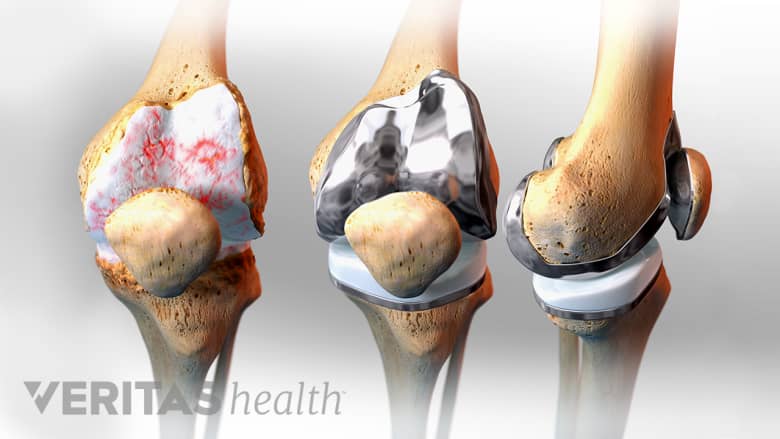Between 4% and 6% of knee replacement surgeries are double knee replacements,1Suleiman LI, Edelstein AI, Thompson RM, Alvi HM, Kwasny MJ, Manning DW. Perioperative Outcomes Following Unilateral Versus Bilateral Total Knee Arthroplasty. J Arthroplasty. 2015;30(11):1927-30. during which both of the patient’s knees are replaced. This procedure is sometimes called bilateral knee replacement.

The goal of knee replacement surgery is to relieve knee pain and increase knee function.
In This Article:
- Double Knee Replacements
- The Pros and Cons of Double Knee Replacement
People considering double knee replacement have moderate to severe knee arthritis in both of their knees. They may find it painful to walk for extended lengths or do other everyday activities.
See 6 Types of Arthritis that Affect the Knee
Double knee replacements have similar short- and long-term results to single-knee replacements. Most patients report a reduction in knee pain and an improvement in function after both surgeries.2Abram SG, Nicol F, Spencer SJ. Patient reported outcomes in three hundred and twenty eight bilateral total knee replacement cases (simultaneous versus staged arthroplasty) using the Oxford Knee Score. Int Orthop. 2016;40(10):2055-2059.,3Latifi R, Thomsen MG, Kallemose T, Husted H, Troelsen A. Knee awareness and functionality after simultaneous bilateral vs unilateral total knee arthroplasty. World J Orthop. 2016;7(3):195-201.
Pros and Cons
Many people consider double knee replacements more efficient and convenient. For example, patients spend less time in the hospital, less time off work, and less time in physical therapy. It also tends to cost less than having two separate surgeries.
See Total Knee Replacement Surgery Recovery
However, there are disadvantages, including an increased risk of blood loss and increased risk of complications. (Though it is worth noting that people who elect to have double knee replacement are exposed to these risks just one time.)
See The Pros and Cons of Double Knee Replacement
Eligibility
Because of the increased risks during and immediately following bilateral knee replacement surgery, most doctors recommend that patients be in good physical condition (with the exception of their arthritic knees).
See Facts and Considerations for Total Knee Replacement
Age requirements
There are no set age requirements for double knee replacements. Some surgeons use a cut-off age—for example, they might only perform double knee replacements on patients aged 60 and younger. Other surgeons evaluate each patient on a case-by-case basis.
See Choosing a Surgeon for Total Knee Replacement
One analysis suggests that people over age 80 can be considered for double knee replacements as long as they meet other surgical criteria.4Cahill CW, Schwarzkopf R, Sinha S, Scott RD. Simultaneous bilateral knee arthroplasty in octogenarians: can it be safe and effective?. J Arthroplasty. 2014;29(5):998-1000.
An Alternative: Staged Knee Replacements
Some people may decide against double knee replacement but decide to have two single knee replacements scheduled close together.
See Knee Surgery for Arthritis
Many surgeons recommend scheduling the two knee replacement surgeries approximately three months apart. A small number of surgeons may consider scheduling surgeries as close as one week apart.5Courtney PM, Melnic CM, Alosh H, Shah RP, Nelson CL, Israelite CL. Is bilateral total knee arthroplasty staged at a one-week interval safe? A matched case control study. J Arthroplasty. 2014;29(10):1946-9.
See How to Prepare for Total Knee Replacement
When scheduling staged knee replacements, the patient and doctor must consider the patient’s overall health and ability to heal and recover between surgeries. If the patient is not adequately recovered from the first knee replacement surgery, he or she may be more prone to infection after the second surgery.6Poultsides LA, Memtsoudis SG, Vasilakakos T, et al. Infection following simultaneous bilateral total knee arthroplasty. J Arthroplasty. 2013;28(8 Suppl):92-5.
- 1 Suleiman LI, Edelstein AI, Thompson RM, Alvi HM, Kwasny MJ, Manning DW. Perioperative Outcomes Following Unilateral Versus Bilateral Total Knee Arthroplasty. J Arthroplasty. 2015;30(11):1927-30.
- 2 Abram SG, Nicol F, Spencer SJ. Patient reported outcomes in three hundred and twenty eight bilateral total knee replacement cases (simultaneous versus staged arthroplasty) using the Oxford Knee Score. Int Orthop. 2016;40(10):2055-2059.
- 3 Latifi R, Thomsen MG, Kallemose T, Husted H, Troelsen A. Knee awareness and functionality after simultaneous bilateral vs unilateral total knee arthroplasty. World J Orthop. 2016;7(3):195-201.
- 4 Cahill CW, Schwarzkopf R, Sinha S, Scott RD. Simultaneous bilateral knee arthroplasty in octogenarians: can it be safe and effective?. J Arthroplasty. 2014;29(5):998-1000.
- 5 Courtney PM, Melnic CM, Alosh H, Shah RP, Nelson CL, Israelite CL. Is bilateral total knee arthroplasty staged at a one-week interval safe? A matched case control study. J Arthroplasty. 2014;29(10):1946-9.
- 6 Poultsides LA, Memtsoudis SG, Vasilakakos T, et al. Infection following simultaneous bilateral total knee arthroplasty. J Arthroplasty. 2013;28(8 Suppl):92-5.

